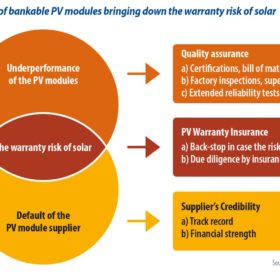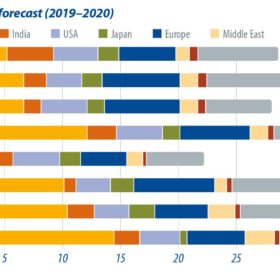Solar’s warranty risk
The warranty risk of solar must be addressed early in the development phase of PV projects, as it is not possible to buy warranty insurance later during the operational phase. Decisions taken by developers at this stage will remain important for the next 25 years. The good news is that an industry standard exists, and it can be easily and cost-effectively applied to most PV projects, writes Ronald Sastrawan from Munich Re.
Three factors for success in the Irish solar market
Recent years have seen an explosion of installed PV capacity across the European Union, fueled by the well-documented rapid reduction in technology costs and favorable subsidy regimes in many jurisdictions. However, one corner of Northern Europe remains relatively untouched by the solar revolution, writes Adam Sharpe of Everoze. The Republic of Ireland currently has the second-lowest amount of installed PV capacity in the European Union, at just 36 MW by the end of 2019.
Terawatt scale by 2022
The solar sector is no stranger to breaking records. Perhaps the most impressive figure to emerge from SolarPower Europe’s new ‘Global Market Outlook’ is that the global solar sector will reach terawatt scale by 2022 – just four years after the 500 GW milestone was reached. Michael Schmela from SolarPower Europe sets out the reasoning behind this and other key findings in the report.
As countries reopen, market recovery begins
As the Covid-19 pandemic gradually eases, countries around the world have slowly begun to relax lockdown measures. Some countries have also launched varying types of economic stimulus to support the solar sector. In contrast to others, the Chinese market is stable, as the country has had some success in controlling the virus.
Universal energy access just got harder
This year marks a uniquely critical juncture on the road to universal access to affordable, reliable, sustainable, and modern energy. The massive disruption caused by Covid-19 complicates the outlook to 2030, which is the target date for reaching UN Sustainable Development Goal (SDG) 7, writes Rohit Khanna, manager of the World Bank’s Energy Sector Management Assistance Program.
Emerging markets and innovation: Twin pillars of the solar tracker market
Global solar tracker shipments reached new record levels in 2019, exceeding 31 GW, up 55% year on year. Exceptional demand in the United States – as well as multiple gigawatt markets in Brazil, Mexico, Chile, Spain and Australia – helped propel the market to new heights, writes Cormac Gilligan, associate director at IHS Markit.
Green electricity tariffs, 1 GW solar tender ‘light at the end of the tunnel’ for Turkish PV
The new 1 GW Yeka tender in Turkey is more than welcome, says KRC Consulting’s Hakki Karacaoglan and Life Enerji’s Ramazan Aslan. Regulations to enable “green electricity” tariffs, also announced this month, add further momentum to the country’s solar sector – allowing Turkish consumers choose renewable energy for their power supply.
Beware of zombies: PV thriving after chaos
In times of crisis, a population usually divides itself into two opinion groups. On the one hand, there are those who believe the storm will pass and things will return to business as usual. And on the other, there are those who took the time to embrace the new reality, accepted it, and now swear that the old world has disappeared and won’t ever come back. In general, writes Becquerel Institute’s Gaëtan Masson, reality splits between the two and makes everyone wrong. And this is what might be about to happen in the solar PV sector.
Module prices plunge as Covid-19 hammers demand
Some European countries and emerging markets are now showing signs of slow recovery, as the Covid-19 pandemic brought overseas markets to a shuddering halt in late March. However, demand is expected to remain weak through the beginning of the third quarter, writes PV InfoLink’s Amy Fang, as it will take time for overseas markets to snap back. Meanwhile, the Chinese market is again busy with the June 30 installation rush, as the government has left tariff timelines unchanged up to the middle of May.
Does corona pave the way for a real Green Deal revolution?
Germany will assume the Presidency of the Council of the European Union on July 1 and will be responsible for progressing EU legislation over the next six months.










